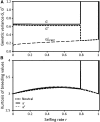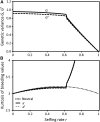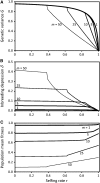Maintenance of Quantitative Genetic Variance Under Partial Self-Fertilization, with Implications for Evolution of Selfing
- PMID: 25969460
- PMCID: PMC4512550
- DOI: 10.1534/genetics.115.176693
Maintenance of Quantitative Genetic Variance Under Partial Self-Fertilization, with Implications for Evolution of Selfing
Abstract
We analyze two models of the maintenance of quantitative genetic variance in a mixed-mating system of self-fertilization and outcrossing. In both models purely additive genetic variance is maintained by mutation and recombination under stabilizing selection on the phenotype of one or more quantitative characters. The Gaussian allele model (GAM) involves a finite number of unlinked loci in an infinitely large population, with a normal distribution of allelic effects at each locus within lineages selfed for τ consecutive generations since their last outcross. The infinitesimal model for partial selfing (IMS) involves an infinite number of loci in a large but finite population, with a normal distribution of breeding values in lineages of selfing age τ. In both models a stable equilibrium genetic variance exists, the outcrossed equilibrium, nearly equal to that under random mating, for all selfing rates, r, up to critical value, [Formula: see text], the purging threshold, which approximately equals the mean fitness under random mating relative to that under complete selfing. In the GAM a second stable equilibrium, the purged equilibrium, exists for any positive selfing rate, with genetic variance less than or equal to that under pure selfing; as r increases above [Formula: see text] the outcrossed equilibrium collapses sharply to the purged equilibrium genetic variance. In the IMS a single stable equilibrium genetic variance exists at each selfing rate; as r increases above [Formula: see text] the equilibrium genetic variance drops sharply and then declines gradually to that maintained under complete selfing. The implications for evolution of selfing rates, and for adaptive evolution and persistence of predominantly selfing species, provide a theoretical basis for the classical view of Stebbins that predominant selfing constitutes an "evolutionary dead end."
Keywords: inbreeding depression; mixed mating; polygenic mutation; purging; stabilizing selection.
Copyright © 2015 by the Genetics Society of America.
Figures







Similar articles
-
Inbreeding depression under mixed outcrossing, self-fertilization and sib-mating.BMC Evol Biol. 2016 May 17;16:105. doi: 10.1186/s12862-016-0668-2. BMC Evol Biol. 2016. PMID: 27188583 Free PMC article.
-
Lifetime inbreeding depression, purging, and mating system evolution in a simultaneous hermaphrodite tapeworm.Evolution. 2014 Jun;68(6):1762-74. doi: 10.1111/evo.12388. Epub 2014 Mar 28. Evolution. 2014. PMID: 24611487
-
Inbreeding depression maintained by recessive lethal mutations interacting with stabilizing selection on quantitative characters in a partially self-fertilizing population.Evolution. 2017 May;71(5):1191-1204. doi: 10.1111/evo.13225. Epub 2017 Apr 10. Evolution. 2017. PMID: 28321843
-
Does the evolution of self-fertilization rescue populations or increase the risk of extinction?Ann Bot. 2019 Jan 23;123(2):337-345. doi: 10.1093/aob/mcy144. Ann Bot. 2019. PMID: 30052766 Free PMC article. Review.
-
Is self-fertilization an evolutionary dead end?New Phytol. 2013 Apr;198(2):386-397. doi: 10.1111/nph.12182. Epub 2013 Feb 20. New Phytol. 2013. PMID: 23421594 Review.
Cited by
-
Fitness consequences of hybridization in a predominantly selfing species: insights into the role of dominance and epistatic incompatibilities.Heredity (Edinb). 2021 Oct;127(4):393-400. doi: 10.1038/s41437-021-00465-2. Epub 2021 Aug 7. Heredity (Edinb). 2021. PMID: 34365470 Free PMC article.
-
The infinitesimal model with dominance.Genetics. 2023 Oct 4;225(2):iyad133. doi: 10.1093/genetics/iyad133. Genetics. 2023. PMID: 37450606 Free PMC article.
-
Increased heterosis in selfing populations of a perennial forb.AoB Plants. 2015 Oct 27;7:plv122. doi: 10.1093/aobpla/plv122. AoB Plants. 2015. PMID: 26507567 Free PMC article.
-
Inbreeding depression under mixed outcrossing, self-fertilization and sib-mating.BMC Evol Biol. 2016 May 17;16:105. doi: 10.1186/s12862-016-0668-2. BMC Evol Biol. 2016. PMID: 27188583 Free PMC article.
-
Can ploidy changes propel the evolution of allogamy in a selfing species complex?BMC Plant Biol. 2025 Aug 1;25(1):1011. doi: 10.1186/s12870-025-06868-1. BMC Plant Biol. 2025. PMID: 40750839 Free PMC article.
References
-
- Armbruster W. S., Reed D. H., 2005. Inbreeding depression in benign and stressful environments. Heredity 95: 235–242. - PubMed
-
- Bull J. J., Charnov E. L., 1985. On irreversible evolution. Evolution 39: 1149–1155. - PubMed
-
- Bulmer M. G., 1971. The effect of selection on genetic variability. Am. Nat. 105: 201–211.
-
- Bürger R., 2000. The Mathematical Theory of Selection, Recombination and Mutation. John Wiley & Sons, Chichester, UK.
Publication types
MeSH terms
LinkOut - more resources
Full Text Sources
Other Literature Sources

